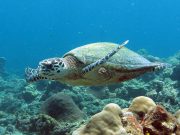Tauchen mit Meeresschildkröten
Meeresleben von Lanta | Chelonioidea
In thailändischen Gewässern kommen 5 Meeresschildkrötenarten vor: Leatherback, Olive Ridley, Loggerhead, Green und Hawksbill. Alle Arten sind durch das thailändische Gesetz zum Schutz der Tierwelt von 1992 geschützt.
Einige Arten, wie die Echte Karettschildkröte, sind vom Aussterben bedroht und können an den meisten Korallenriffen beim Tauchen auf Koh Lanta beobachtet werden.
Die fünf in thailändischen Gewässern vorkommenden Arten können wie folgt identifiziert werden:
- Muster des Panzers (Schale)
- Lederschildkröte - 5 ausgeprägte Rippen, keine Schuppen
- Grün, Hawksbill, Loggerhead, Olive Ridley - keine durchgehenden Rippen, Schalenplatten
- Seitliche Schuppen
- Grüner und Hawksbill - 4 Paar seitliche Schuppen, der erste seitliche nicht in der Nähe des seitlichen Halses
- Stachelmakrele - 5 Paar seitliche Schuppen, erster seitlicher Schuppen nahe dem Nacken seitlich
- Olive Ridley - 6 bis 8 Paare seitlicher Schuppen, der erste seitliche nahe dem Hals seitlich
Die Männchen haben längere Schwänze als die Weibchen, und die meisten der Schildkröten, die wir um Koh Lanta beobachtet haben, sind Weibchen.
Die Brut- und Aufzuchtstation für Meeresschildkröten auf dem Marinestützpunkt Phang Nga wurde 1995 eröffnet und setzt heute jährlich über 10.000 Schildkröten aus. Die Eier werden auf der Insel Hooyong in den Similans ausgebrütet, unmittelbar nach dem Schlüpfen aus dem Nest eingesammelt und in die Aufzuchtstation gebracht.
Weltweit überleben weniger als 0,1 % der geschlüpften Schildkröten bis zum Erwachsenenalter, während 40 % der Jungtiere des Royal Thai Navy Sea Turtle Conservation Center Phang Nga Naval Base bis zum Erwachsenenalter überleben.
Die Informationen auf dieser Seite stammen vom Meeresschildkröten-Schutzzentrum, Phang Nga Naval Base, Khao Lak
3 Arten auf dieser Seite gefunden:
Hawksbill Turtle
(Eretmochelys imbricata)
The hawksbill turtle is easily identified by its sharp hawk-like hooked-beak, and yellowish-brown visibly overlapping scutes on it carapace (shell). The beauty of its scutes has resulted in excessive hunting for accessories production.
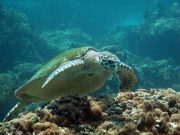
Eretmochelys imbricata @ Koh Bida
Their habitat is coral reefs and they eat bubble corals, sponges, sea snails and various marine animals. This turtle is critically endangered.
Some of the sponges and small animals that hawksbill turtles eat contain toxic substances. The turtles are not affected by these toxins, however these chemicals are collected in their body fat, and may pose a serious risk to humans who eat turtle meat.
The maximum size of hawksbill turtles is around 95cm and maximum weight around 60kg.
Hatching area in Thailand: Thai Gulf and Andaman Coast.
Green Turtle
(Chelonia mydas)
Green Turtles have a large pair of brown and white paddle-like flippers with maximum size of maturity is 120cm. And maximum weight is 150 kg. Its habitat is coastal areas, sea grass and seaweed are its main food and its spawning sources in Thailand are in beaches of Kram Islands, Similan Islands, Adang-Ravi Islands and Kra Island.
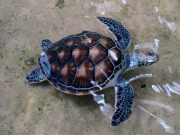
Juvenile Chelonia mydas @ Phang Nga
Green turtles begin their lives eating plants, fish and jellyfish, but become vegetarians as they grow older.

Adult Green Turtles @ Phang Nga

2 week old Green Turtle @ Phang Nga
Green turtles have yellow-brown shells reminiscent of the sky at sunset. They have the hardest shell in the world.
Hatching area in Thailand: multiple locations in both Thai Gulf and Andaman Coast.
Green turtle is named after the colour of their cartilage and fat. Lifespan in the wild up to 80 years.
Females nest at intervals of 2 -4 years, with average of 3 - 5 nests per season. Around 115 eggs are laid in each nest, with incubation period of around 60 days.
Green turtle photos taken at the:
- Sea Turtle Conservation Center, Phang Nga Naval Base, Khao Lak
- Thai Muang Turtle Sanctuary "Turtle Heaven", Phang-nga Coastal Fisheries Research and Development Center, Phang Nga
Olive Ridley Turtle
(Lepidochelys olivacea)
Olive Ridley Turtle is a small sea turtle with an adult carapace length of 75cm and its maximum weight is 50kg. The carapace is grey with 6-9 pairs of lateral scutes, its habitat is coastal area and small marine animals such as shrimp, shellfish, crab and fish are its food.
This turtle lives in the seas around Koh Lanta and all of our dive sites, and can be seen during boat trips to/from dive sites, but it rarely seen on the actual dive sites.
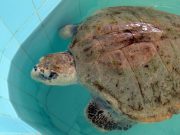
Lepidochelys olivacea @ Phang Nga
Olive Ridley Sea Turtle has spawning behaviour different from other sea turtles. Huge groups of 1,000 - 10,000 female turtles gather together to spawn simultaneously, called the ‘Arribada’ phenomenon in Orissa State in India.
There is no ‘Arribada’ phenomenon in Thailand ,but its spawning source is in the west coast of Phuket and Phangnga provinces.
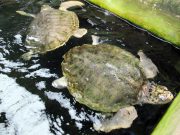
Olive Ridley Turtle @ Phang Nga
The Olive Ridley Turtle has a smooth grey-green shell and a big beak. It is the smallest species of sea turtles.
The diet consists of sea weeds and sea creatures like shrimps and snails.
The hatching area in Thailand is the Andaman Coast, though we don't see them here on Lanta's beaches.
Diet: Omnivore, molluscs and crustacean. Nests 3 times annually with 100 - 110 eggs per nest. Average life expectancy is 50 years.
Olive Ridley Turtle photos taken at the:
- Sea Turtle Conservation Center, Phang Nga Naval Base, Khao Lak
- Thai Muang Turtle Sanctuary "Turtle Heaven", Phang-nga Coastal Fisheries Research and Development Center, Phang Nga
Tauchen mit Meeresschildkröten rund um Koh Lanta
Tauch- und Schnorchelausflüge
Wenn Sie gerne die Gelegenheit hätten, Meeresschildkröten auf einem unserer täglichen Tauchausflüge während der Hochsaison von Koh Lanta aus zu sehen, dann senden Sie uns eine E-Mail an info@diveandrelax.com.
Nehmen Sie an unseren Speedboot-Tauchausflügen in der Hochsaison zu einigen der besten Tauchplätze Thailands teil und genießen Sie kleine Gruppen, kurze Fahrzeiten und einen Fokus auf hervorragenden persönlichen Service, Sicherheit und Spaß.
Noch kein zertifizierter Taucher? Lernen Sie auf Koh Lanta das Tauchen mit dem 3-tägigen SSI Open Water Diver Kurs.
Buchen Sie online und sparen Sie 10% auf Tauchausflüge und Tauchkurse auf Koh Lanta.
Weitere Informationen
Indo-Pazifische Meereslebewesen-Führer
- Allen, G., Steene, R., Humann, P., DeLoach, N. (2003) Reef Fish Identification, Tropical Pacific. Jacksonville, FL., USA: New World Publications, Inc., ISBN 1-878348-36-1.
- Humann, P., DeLoach, N., (2010) Reef Creature Identification, Tropical Pacific. Jacksonville, FL., USA: New World Publications Inc., ISBN 978-1-878348-44-9
- Debelius, H. (2013) Indian Ocean Reef Guide. Frankfurt, Germany: IKAN - Unterwasserarchiv, ISBN 978-3-939767-52-7.
- Debelius, H. (2004) Nudibranchs and Sea Snails, Indo-Pacific Field Guide. Frankfurt, Germany: IKAN - Unterwasserarchiv, ISBN 3-925919-51-1
- Erhardt, H., Knop, D. (2015) Corals Indo-Pacific Field Guide. Frankfurt, Germany: IKAN - Unterwasserarchiv, ISBN 3-925919-69-4.
- Veron J.E.N., Stafford-Smith M.G., Turak E. and DeVantier L.M. (2016). Corals of the World
Weitere Referenzen zu Meereslebewesen und weitere Informationen

